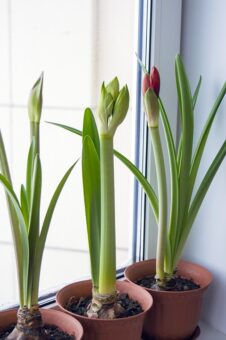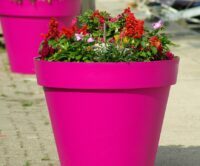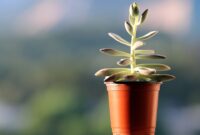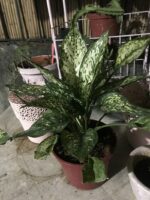In this part of the series, we will be discussing using plastics containers in your garden. In the first part, we discussed how terracotta containers can be used to great effect, but now we concentrate on the more widely used plastics.

Plastic containers you tend to find in shops, garden centres, online and are sold everywhere. They all come in different shapes and sizes from less than a litre, up to large 100 litres + containers. They can be standard tubs, troughs, planters, window boxes, wall planters or hanging baskets. No matter where you look, you will see a plastic container of some sort, even in gardens that traditionally do not use them, such as a tender specimen in borders.
You can buy modern-looking plastic designs or you can buy classical urns and ornate containers in any style imaginable. You can leave them as you bought them or if you are a bit more adventurous you can use a variety of painted effects to bling up the containers. Plastic paints are handy for this and you can stencil any design you want on them. Turn boring plastic containers into something more elaborate.
GROWING IN PLASTIC CONTAINERS IS SLIGHTLY DIFFERENT
Growing in plastic containers is slightly different than growing in terracotta, as plastics tend to hold moisture better, so the growing media dries out less quickly.
This is beneficial on hot, sunny days but this can be a disadvantage at the beginning of the growing season, as small, young plants have shallow roots and tend to use less water, especially so if the weather is cool.
This means you can have oversized container at the beginning of the growing season. It is easy to overwater plants in plastic containers, especially if you are using multipurpose compost with high peat content. This is because peat tends to act as a sponge, holding on to water.

This must be considered when you are selecting plants. As plants that like their roots to be drier than normal will not do as well.
It is advised when you are watering young plants that you take care not to overwater, causing root rot to set in and the possibility of killing the plant within.
Once the plant has established you can water more liberally but you will still have to watch out to make sure the compost is never waterlogged.
DRAINAGE IN PLASTIC CONTAINERS IS DIFFERENT
The drainage in plastic containers also tends to be different, as often they come with a lot of small holes at the bottom of the container. Often they come with holes but this is not guaranteed, as some plastic containers have no hole at all.

If they come with several holes at the base, it is best not to cover them with crocks, especially so if you are using a growing media that is more fibrous in texture. If the container has no drainage holes then you will need to create some by using an awl or a drill. It is best to have around a dozen, small 4mm in diameter holes to help make sure that the compost is free-draining, especially important to avoid waterlogging the plants within.
It is a fine balance between the two; you do not want too many holes that will lose too much water quickly and you do not want to few holes so that the compost becomes waterlogged.
Some gardeners prefer using plastic containers for their annuals or biennials and using more specialised material of construction for more permanent specimens. This is probably a throwback to when the containers that you could buy whereof such poor quality that any sunlight and frosts set them to disintegrate over time.
GONE IS THE POOR QUALITY PLASTIC CONTAINERS
The past has gone and nowadays the plastic you buy is good enough to last for a much longer time. They can be used in full sun so that the UV light takes longer to break down the plastics, and can survive in frosty conditions.

One of the biggest advantages of plastics is that they are lightweight, which makes it easier to carry around, even with a plant in. This is great if you grow a tender plant in one plastic container and you need to move it to a conservatory or greenhouse in winter. In terracotta or stone containers this will not be practical.
Although container can come in any colour under the sun, the most popular ones are green, black and terracotta. Plastics pots aim to make the plant or plants within them the star and not the container itself. In more elaborate displays you can make more of the container the feature but this will steal the thunder from the plants that grow within.
YOU CAN USE A LARGE TUB TO CREATE A WATER FEATURE
Large plastic tubs make a good container for miniature water features with a fountain in the middle. This will be discussed in a later article, where I will be discussing various ways that you can make a water feature in a container.
They are safer than having a full-sized pond in your garden, especially if you have small children. You can still have the sounds of running water in the garden but at much less risk.
If you want a container that offers a certain amount of natural insulation to the roots of the plant itself, then containers made out of Styrofoam is for you. This is ideal as in summer, where the root needs to be cooled but in winter they will get some insulation.
If you are looking for more self-sufficient containers, then you can buy self-watering containers, which need to be watered less often. This is because they have a water reservoir to which the plants have access to. The good thing about these is the roots will never be in contact with the water causing them to root. Self-watering containers are great for those who forget to water or for those who like to take regular holidays.
PLANTS SUITABLE FOR PLASTIC CONTAINERS
Plastic pots are ideal when you need a large container to have a dramatic display to which any other sized containers would be prohibitively expensive. You can grow anything in plastic pots frim shrubs, small trees, annuals, perennials, grasses, sedges, bulbs, fruit and vegetables. You are not limited but most people tend to use them to give a riot of colours during the summer months full of bedding plants.
This means that you can use Ageratum, Linaria, Fuchsia, Impatiens, Begonia, Petunias, Marigold, Nicotania etc. If you want a mixed display, use naturally compact varieties of annual bedding plants. The smaller they are, the better the display will be in your garden in plastic containers.
CONCLUSIONS
In this article, we have discussed why you as a gardener may want to use plastic container in your garden. You do have a wide choice in different sizes, forms, colours and heights. If you want a plastic container in your garden for a certain purpose you will have no trouble in finding one.
You can use them to create a water feature, a container to display your summer bedding in or you can use a more elaborate display to show your featured plants in.
You can use Styrofoam plastic pots to insulate your plant, or you can buy self-watering containers for those who tend to be forgetful to water your plants. This means that you are not limited and you can use any plastic container to fulfil your garden designs to your hearts desires.
If you have any comments or questions that you wish to make, please do so in the comment box below,
Happy container gardening.


